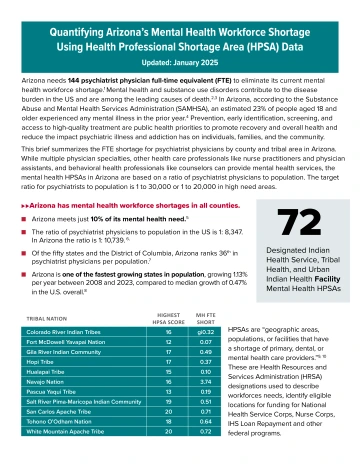AzCRH Workforce Reports & Briefs
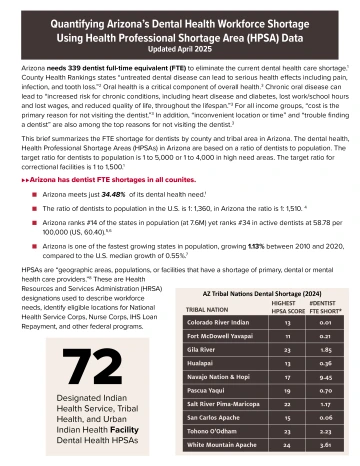
Quantifying Arizona’s Dental Health Workforce Shortage Using Health Professional Shortage Area (HPSA) Data
Publication Date: Thursday, April 24, 2025
Publication Authors: Koch B, Drake, C, Garn, A. and Derksen, D
The purpose of this brief is to summarize the Full-Time-Equivalent (FTE) shortage of the dental health care workforce by county and tribal area in Arizona. The brief uses Health Resources and Services Administration (HRSA) Health Professional Shortage Area (HPSA) data to summarize the dentist FTE shortage and the number of facilities with a dental health professional HPSA shortage designation.
Quantifying Arizona’s Mental Health Workforce Shortage Using Health Professional Shortage Area (HPSA) Data
Publication Date: Tuesday, January 7, 2025
Publication Authors: Koch B, Drake, C, Garn, A. and Derksen, D
The purpose of this brief is to summarize the Full-Time-Equivalent (FTE) shortage of psychiatrist physicians by county and tribal area in Arizona. The brief uses Health Resources and Services Administration (HRSA) Health Professional Shortage Area (HPSA) data to summarize the psychiatrist physician FTE shortage and the number of facilities with a mental health professional HPSA shortage designation.
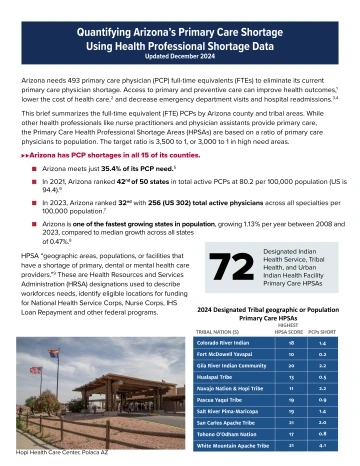
Quantifying Arizona’s Primary Care Shortage Using Health Professional Shortage Area (HPSA) Data
Publication Date: Thursday, December 5, 2024
Publication Authors: Koch B, Drake, C, Garn, A. and Derksen, D
The purpose of this brief is to summarize the Full-Time-Equivalent (FTE) shortage of primary care physicians (PCPs) by county and tribal area in Arizona. The brief uses Health Resources and Services Administration (HRSA) Health Professional Shortage Area (HPSA) data to summarize the PCP FTE shortage and the number of facilities with a HPSA designation.
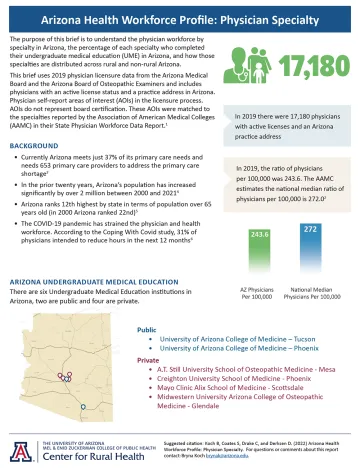
Arizona Health Workforce Profile: Physician Specialty
Publication Date: Wednesday, September 21, 2022
Publication Authors: Koch B, Coates S, Drake, C, and Derksen D
The purpose of this brief is to understand the physician workforce by specialty in Arizona, the percentage of each specialty who completed their undergraduate medical education (UME) in Arizona, and how those specialties are distributed across rural and non-rural Arizona.
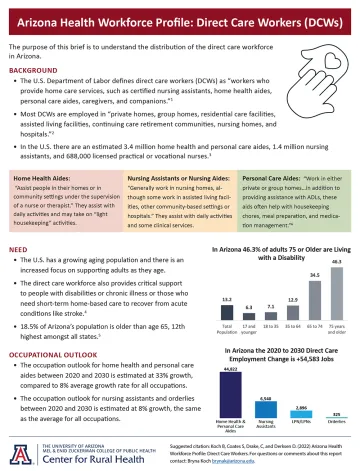
Arizona Health Workforce Profile: Direct Care Workers
Publication Date: Thursday, April 21, 2022
Publication Authors: Koch B, Coates S, Drake, C, and Derksen D
Arizona Health Workforce Profile: Direct Care Workers. This brief summarizes the distribution of the direct care workforce across Arizona’s counties and compares the distribution between rural and on-rural counties.
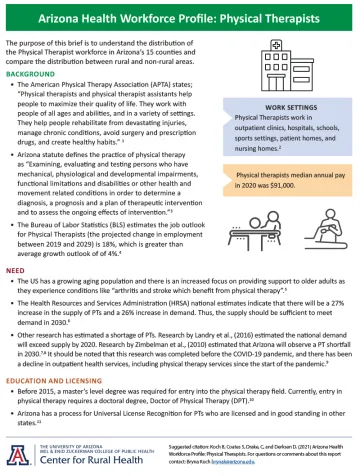
Arizona Health Workforce Profile: Physical Therapists
Publication Date: Tuesday, September 28, 2021
Publication Authors: Koch B, Coates S, Drake, C, and Derksen D.
Arizona Health Workforce Profile: Physical Therapists This brief summarizes the distribution of the physical therapist workforce across Arizona’s 15 counties and compares the distribution between rural and non-rural counties.
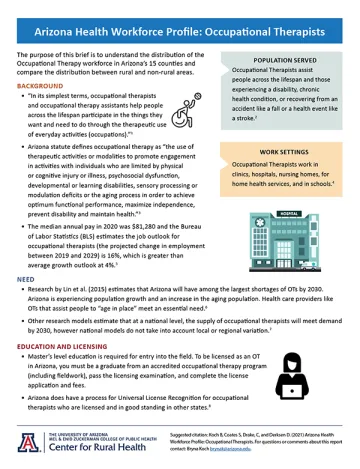
Arizona Health Workforce Profile: Occupational Therapists
Publication Date: Monday, July 26, 2021
Publication Authors: Koch B, Coates S, Drake, C, and Derksen D.
This brief summarizes the distribution of the occupational therapist workforce across Arizona’s 15 counties and compares the distribution between rural and non-rural counties.

The Arizona Critical Care Workforce Brief
Publication Date: Wednesday, April 21, 2021
Publication Authors: Koch B, Coates S, Drake, C, and Derksen D.
This brief summarizes the distribution of the critical care infrastructure and critical care workforce across Arizona’s 15 counties and compares the distribution between rural and non-rural counties. The Brief includes data on hospitals, Intensive Care units (ICUs), and the critical care health workforce including critical care physicians, critical care nurses, and respiratory therapists.

Publication Date: Tuesday, November 17, 2020
Publication Authors: Koch B, Coates S, and Derksen D
This brief summarizes the main findings of the Arizona Behavioral Health Workforce Report. The Brief includes data on psychiatrists, psychologists, behavior analysts, social workers, counselors, marriage and family therapists, and substance abuse counselors. Arizona only meets just 40% of its current mental health workforce need and the data in this brief show disparities between urban and rural areas in the provider per population ratios.
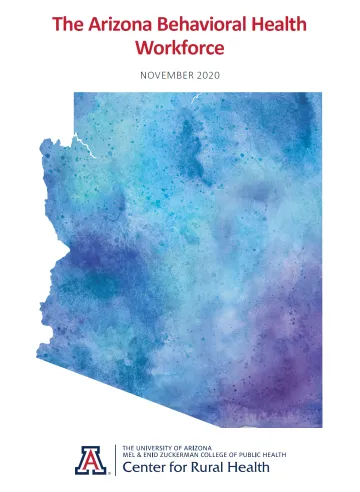
Publication Date: Tuesday, November 17, 2020
Publication Authors: Koch B, Coates S, Brady B, Peters J, and Derksen D
The Arizona Behavioral Health Workforce Report is intended to inform Arizona health workforce policies to support a well-distributed and accessible behavioral health workforce. It has two aims: (1) describe behavioral health and access to behavioral healthcare in Arizona, and (2) use workforce data to describe rural and non-rural differences in the distribution of Arizona behavioral healthcare providers. Mental health and substance use disorders contribute to disease burden in the US and are among the leading causes of death. Prevention, early identification, screening, and access to high-quality treatment are public health priorities. Arizona meets just 40% of its current mental health care workforce needs and ranks 47th in in terms of behavioral health workforce availability. There are disparities in workforce across urban and rural areas in Arizona. The behavioral health workforce as measured by provider per 100,000 population ratio is four to five percent higher than the percent of the population living in urban areas than in rural areas for all professions except substance abuse counselors. Psychiatrists mostly practice in urban areas (96.7%), also exceeding the percent of the population living in urban areas (92%) by almost five percent.
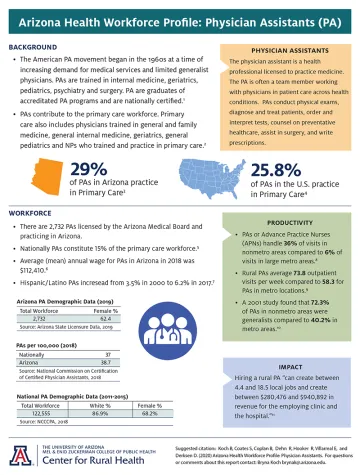
Publication Date: Thursday, May 14, 2020
Publication Authors: Koch B, Coates S, Coplan B, Dehn R, Hooker R, Villarreal E, and Derksen D.
Physician Assistants (PA) are a core component of the health workforce, including the primary care workforce in Arizona. Although the distribution of PAs is concentrated in urban population centers, hiring a PA in a rural area can have a positive community and economic impact. This brief provides an overview of the PA workforce in Arizona including geographic distribution by county and rural geography.

Publication Date: February 20, 2020
Publication Authors: Koch B, Coates S, Brady B, Campos-Outcalt D, Carter H, and Derksen D.
A high-quality maternal health care system relies in part on the right number of well-trained women’s health providers in the right locations (Rayburn, 2017; U.S. Department of Health and Human Services, Health Resources and Services Administration, 2016). According to national estimates, Arizona and other states are anticipated to experience an ob-gyn shortage (U.S. Department of Health and Human Services, Health Resources and Services Administration, 2016). Using licensure data, we found that there are geographic disparities in the distribution of ob-gyn physicians across Arizona. The ratio of ob-gyns per 10 000 women in urban areas is 2.1, compared to 1.5 in large rural city/towns and 1.1 in small rural towns. There are no practicing ob-gyn physicians in isolated small rural towns. This geographic distribution is mirrored in the CNM workforce, which similarly favors urban over rural areas.
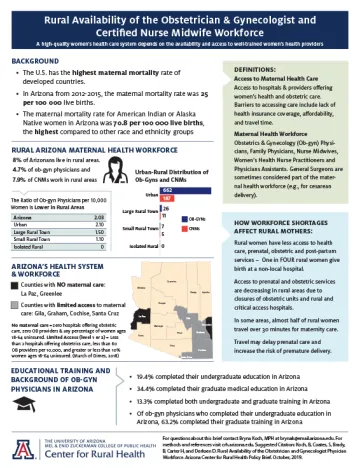
Publication Date: January 30, 2020
Publication Authors: Koch, B, Coates, S, Brady, B, Carter H, and Derksen D.
Women’s and maternal health begins where women live, learn and work. Access to timely and high-quality women’s health and primary care services is also an essential component of a supporting maternal health. According to the March of Dimes, Greenlee and La Paz counties are maternal care deserts and Cochise, Gila, Graham, and Santa Cruz counties have limited access to maternal care. Women in rural Arizona face barriers to maternal health care including a lower ratio of Ob-gyn providers per population. In general, women in rural areas have additional barriers like longer drive-times and fewer facilities offering obstetric services.
» For more details on the sources methods for the workforce brief, see statement here.
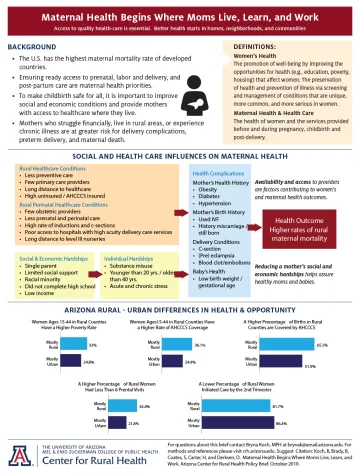
Publication Date: October 29, 2019
Publication Authors: Koch, B, Brady, B, Coates, S, Carter, H, and Derksen, D.
Women’s and maternal health begins where women live, learn and work. Access to timely and high-quality women’s health and primary care services is also an essential component of a supporting maternal health. According to the March of Dimes, Greenlee and La Paz counties are maternal care deserts and Cochise, Graham Pinal, and Santa Cruz counties have limited access to maternal care. Women in rural Arizona face barriers to maternal health care including a lower ratio of Ob-gyn providers per population. In general, women in rural areas have additional barriers like longer drive-times and fewer facilities offering obstetric services.
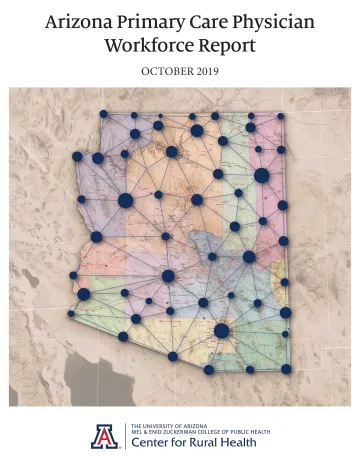
Publication Date: October 2019
Publication Authors: Koch B, Coates S, Campos-Outcalt D, Carter H, and Derksen D.
This report aims to provide data on the distribution of the physician workforce and the differences in the distribution of physicians by training location and specialty. This data can assist in efforts to ensure that Arizona develops programs and policies that build a health care system that addresses the needs of all communities.
- AzCRH 2015 Supply and Demand Study of Arizona Health Practitioners and Professionals
- AzCRH 2015 Arizona Pharmacist Supply and Demand Report
- The Supply of Physician Assistants, Nurse Practitioners, and Certified Nurse Midwives in Arizona (June 2014)
- Arizona Rural Health Workforce Study | Accompanying Policy Brief


